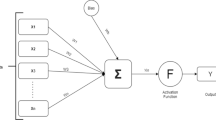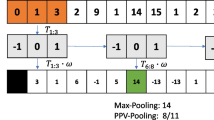Abstract
The financial time series is inherently nonlinear and hence cannot be efficiently predicted by using linear statistical methods such as regression. Hence, intelligent predictor has been developed and reported which is suitable for nonlinear time series. But such predictors require that the past financial data are available at the location of the predictor which is not the case in many real-life situations. Hence, when the financial data are available at different places and a single intelligent predictor needs to be developed, the task becomes challenging. In the current work, this problem has been addressed and solved using a low-complexity artificial neural network and employing incremental and diffusion learning strategies. In the current study, distributed prediction of three different types of time series such as exchange rates, stock indices and net asset values has been carried using incremental and diffusion-based learning strategies. The results of different days ahead prediction of two proposed low computational complexity-based functional link artificial neural network are compared with those obtained by conventional intelligent method. The results of simulation-based experiments reveal similar or improved prediction performance of the proposed distributed predictors compared to conventional one. In addition, saving in band width, memory and power are achieved in this method.










Similar content being viewed by others
References
Kaastra I, Boyd M (1996) Designing a neural network for forecasting financial and economic time series. Neurocomputing 10(3):215–236
Tan TZ, Quek C, Ng GS (2005) Brain inspired genetic complimentary learning for stock market prediction. IEEE Congr Evol Comput 3:2653–2660
Lin HS, Chen ML, Tong CC, Dai JW (2007) Using grey and RBFNN to Predict the net asset value of single nation Equity Funds—a case study of Taiwan, US, and Japan. In: Proceedings of IEEE international conference on grey systems and intelligent services, pp 892–897
Yu L, Lai KK, Wang S (2008) Multistage RBF neural network ensemble learning for exchange rates forecasting. Neuro Comput 71:3295–3302
Majhi R, Panda G, Majhi B, Sahoo G (2009) Efficient prediction of stock market indices using adaptive bacterial foraging optimization (ABFO) and BFO based techniques. Expert Syst Appl 36(6):10097–10104
Li D, Wang W, Ismail F (2013) Fuzzy neural network technique for system state forecasting. IEEE Trans Cybern 43(5):1484–1494
Pulido M, Melin P, Castillo O (2014) Particle swarm optimization of ensemble neural networks with fuzzy aggregation for time series prediction of the Mexican Stock Exchange. Inf Sci 280:188–204
Korol T (2014) A fuzzy logic model for forecasting exchange rates. Knowl-Based Syst 67:49–60
Wang L, Wang Z, Zhao S, Tan S (2015) Stock market trend prediction using dynamical Bayesian factor graph. Expert Syst Appl 42:6267–6275
Shen F, Chao J, Zhao J (2015) Forecasting exchange rate using deep belief networks and conjugate gradient method. Neuro Comput 167:243–253
Moghaddam AH, Moghaddam MH, Esfandyari M (2016) Stock market index prediction using artificial neural network. J Econ Fin Admin Sci 21:89–93
Hsu MW, Lessmann S, Sung MC, Ma T, Johnson JEV (2016) Bridging the divide in financial market forecasting: machine learners versus financial economists. Expert Syst Appl 61:215–234
Lopes CG, Sayed AH (2007) Incremental adaptive strategies over distributed networks. IEEE Trans Signal Process 55(8):4064–4077
Johansson B, Keviczky T, Johansson M, Johansson KH (2008) Subgradient methods and consensus algorithms for solving convex optimization problems. In: IEEE conference on decision and control, pp 4185–4190
Johansson B, Speranzon A, Johansson M, Johansson KH (2008) On decentralized negotiation of optimal consensus. Automatica 44:1175–1179
Schizas ID, Mateos G, Giannakis GB (2009) Distributed LMS for consensus-based in-network adaptive processing. IEEE Trans Signal Process 57(6):2365–2382
Cattivelli FS, Sayed AH (2010) Diffusion strategies for distributed Kalman filtering and smoothing. IEEE Trans Autom Control 55(9):2069–2084
Cattivelli FS, Sayed AH (2010) Diffusion LMS strategies for distributed estimation. IEEE Trans Signal Process 58(3):1035–1048
Wang X, Mou S, Sun D (2016) Improvement of a distributed algorithm for solving linear equations. IEEE Trans Ind Electron 64(4):3113–3117
Zhao Z, Feng J, Peng B (2016) A green distributed signal reconstruction algorithm in wireless sensor networks. Special section on green communications and networking for 5 g wireless. IEEE Access 4:5908–5917
Yu Zhao H (2016) Incremental M-estimate-based least-mean algorithm over distributed network. Electron Lett 52(14):1270–1272
Qin J, Fu W, Gao H, Zheng WX (2017) Distributed k-means algorithm and fuzzy c-means algorithm for sensor networks based on multi agent consensus theory. IEEE Trans Cybern 47(3):772–783
Author information
Authors and Affiliations
Corresponding author
Ethics declarations
Conflict of interest
The authors declare that they have no conflict of interest.
Rights and permissions
About this article
Cite this article
Mohapatra, U.M., Majhi, B. & Satapathy, S.C. Financial time series prediction using distributed machine learning techniques. Neural Comput & Applic 31, 3369–3384 (2019). https://doi.org/10.1007/s00521-017-3283-2
Received:
Accepted:
Published:
Issue Date:
DOI: https://doi.org/10.1007/s00521-017-3283-2




